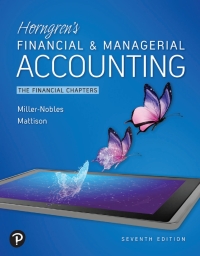Question
1. Cash outflows generated by capital investments include all of the following except: a. Incremental revenues. b. Increase in operating expenses. c. Initial investment in
1. Cash outflows generated by capital investments include all of the following except: a. Incremental revenues. b. Increase in operating expenses. c. Initial investment in the capital asset. d. Increase in working capital.
2. Eddy Company has an opportunity to purchase an asset that will cost the company $25,000. The asset is expected to add $7,500 per year to the company's net income. Assuming the asset has a five-year useful life and zero salvage value, the unadjusted rate of return will be: a. 10%. b. 3%. c. 30%. d. 20%.
3. An investment that costs $30,000 will produce annual cash flows of $10,000 for a period of 4 years. Given a desired rate of return of 8%, the benefit of the investment today is: a. $40,000. b. $30,000. c. $25,000. d. $33,121.
4. Jim Tyler is evaluating a potential capital investment. He has calculated the net present value using a minimum rate of return of 10%. Using this rate, the net present value is negative. What does this tell him about the rate of return expected for the project? a. If the net present value is negative; the expected rate of return for the project is equal to the 10% minimum or required rate of return. b. Cannot determine from the information given. c. If the net present value is negative; the expected rate of return for the project is less than the 10% minimum or required rate of return. d. If the net present value is negative; the expected rate of return for the project is greater than the 10% minimum or required rate of return.
Step by Step Solution
There are 3 Steps involved in it
Step: 1

Get Instant Access to Expert-Tailored Solutions
See step-by-step solutions with expert insights and AI powered tools for academic success
Step: 2

Step: 3

Ace Your Homework with AI
Get the answers you need in no time with our AI-driven, step-by-step assistance
Get Started


